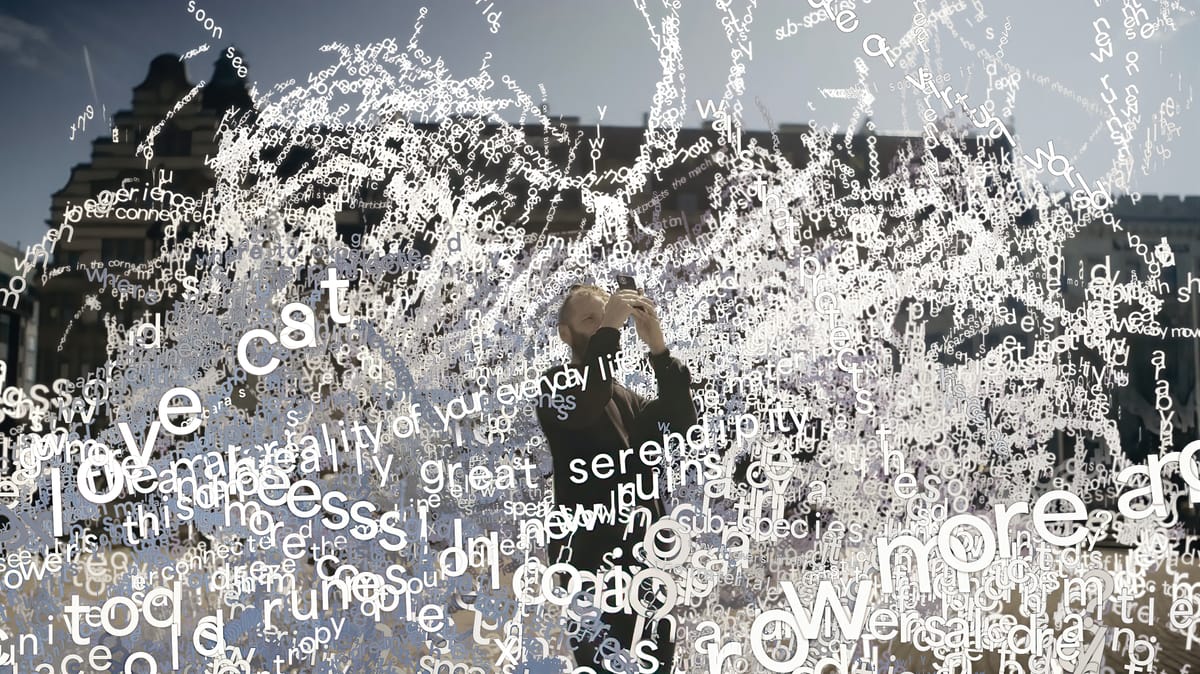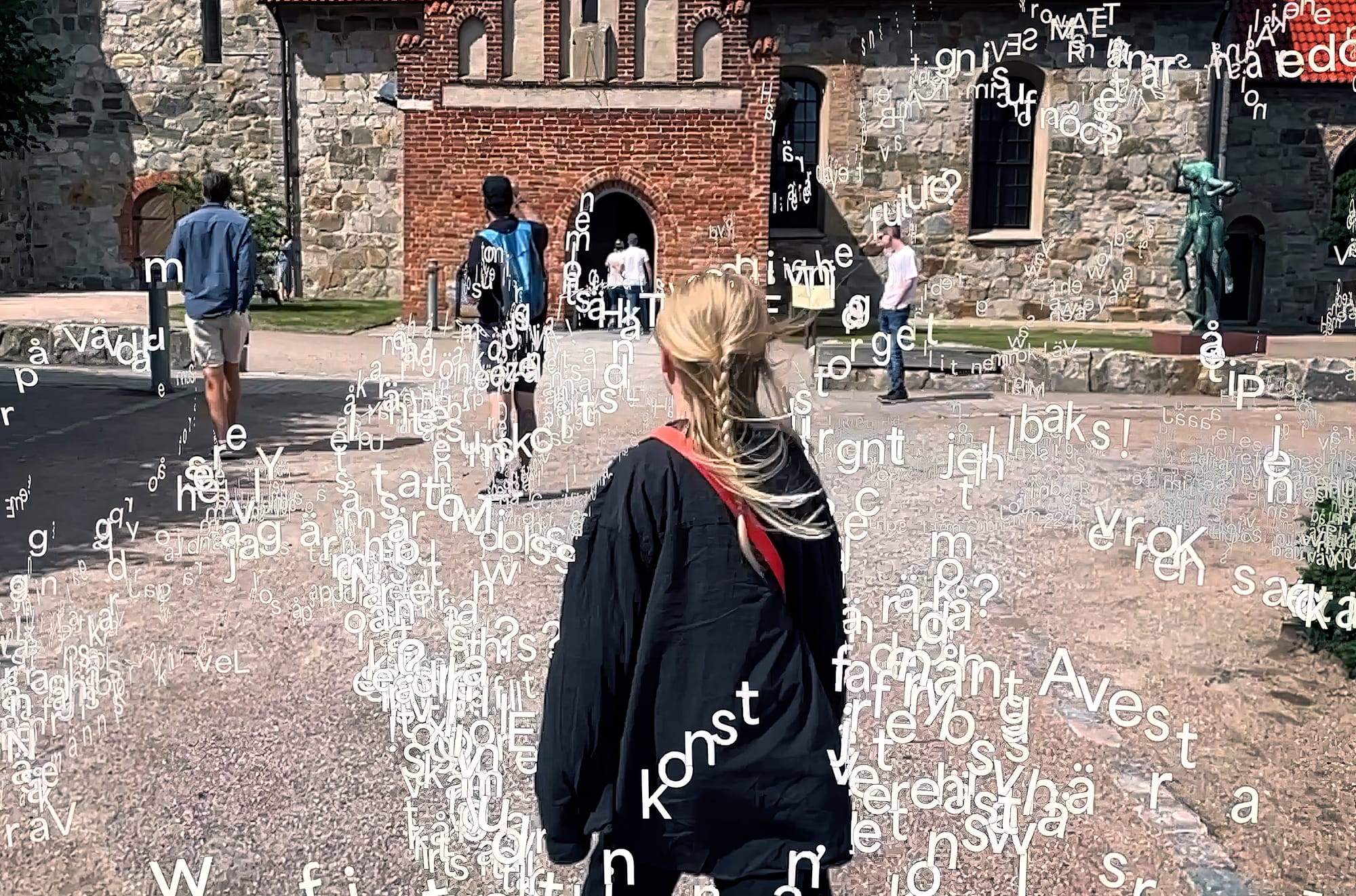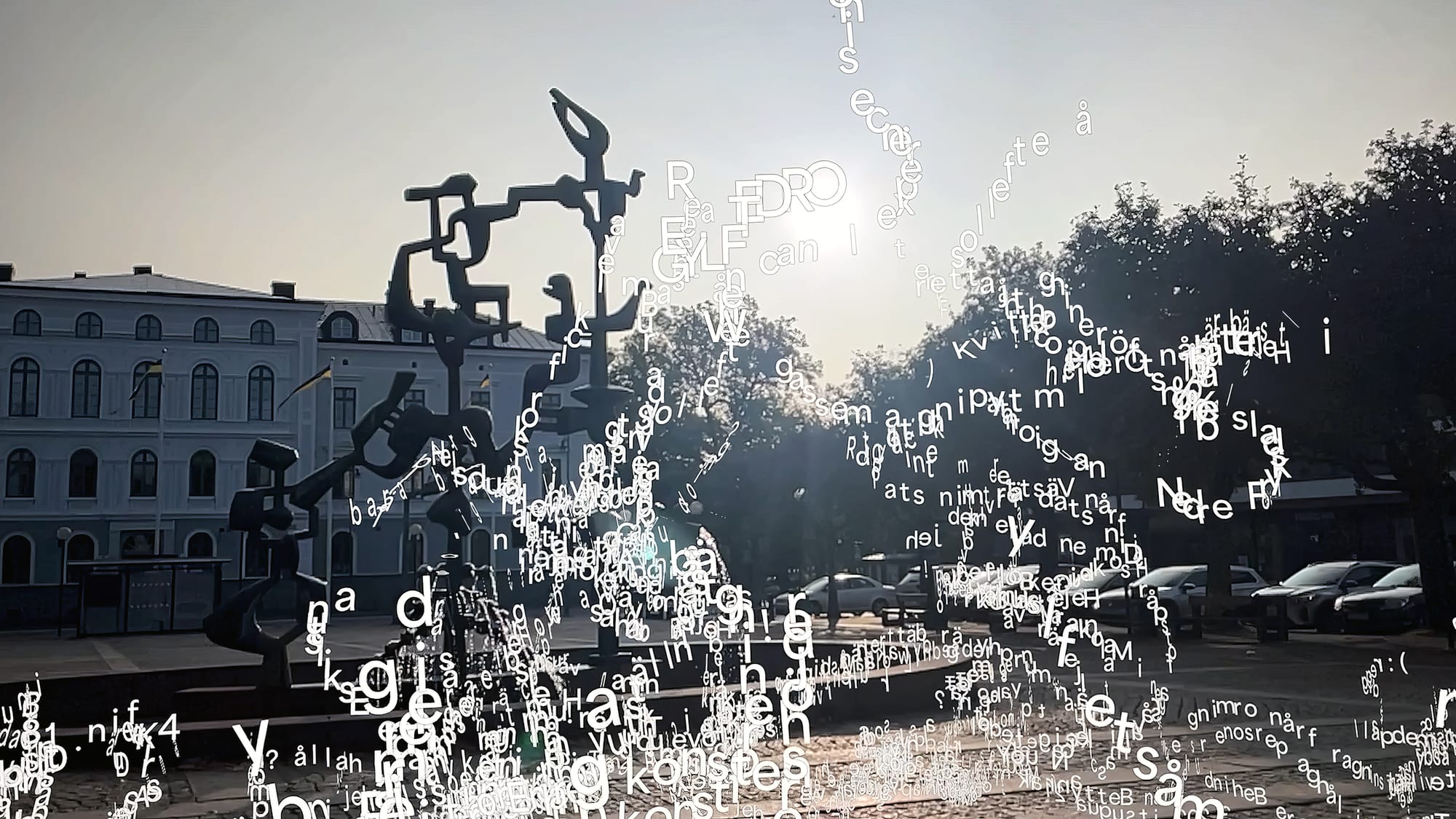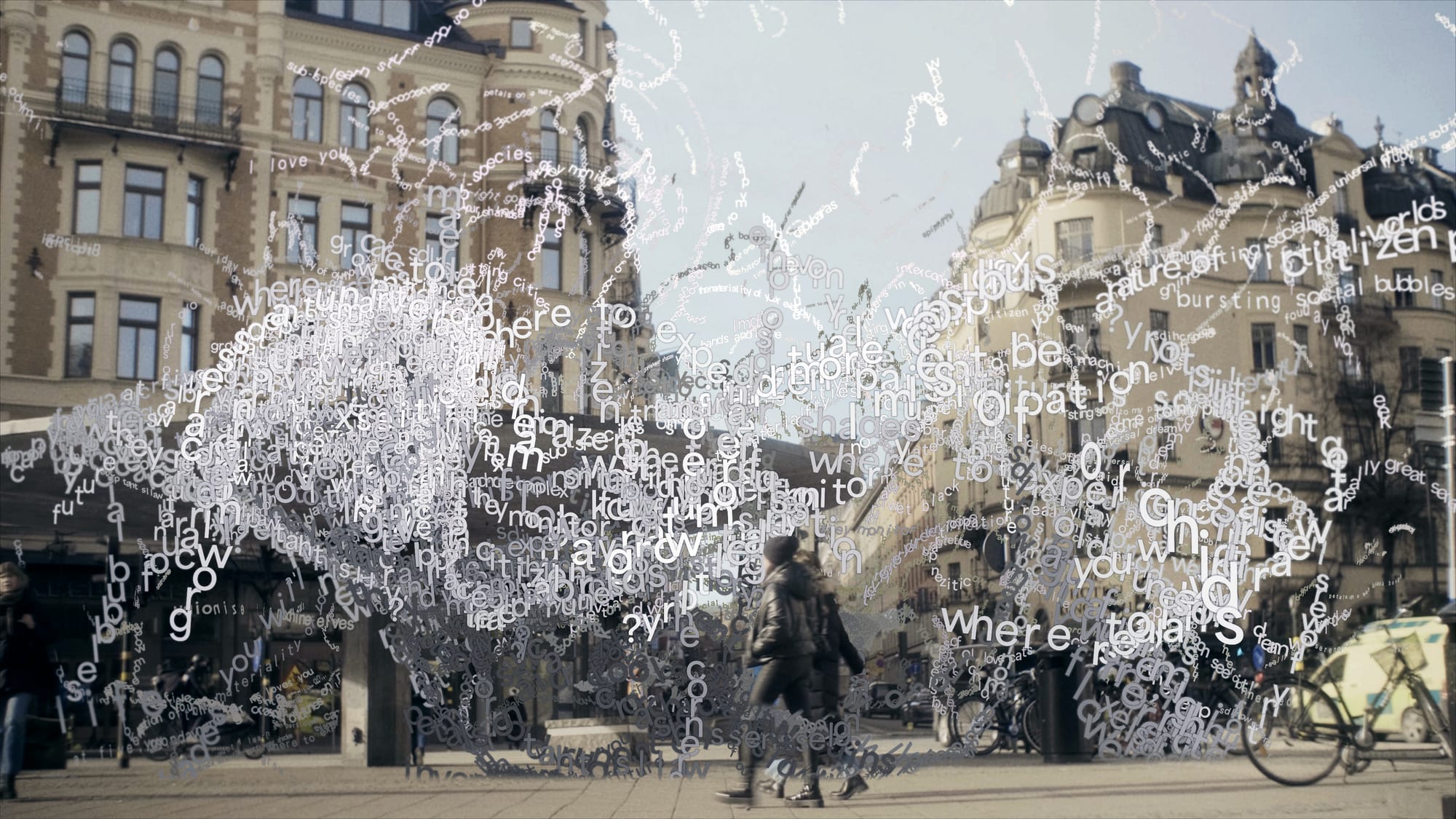Interspatial Echoes / Det långa sorlet

Interspatial Echoes (Swedish title: Det långa sorlet) is exhibited at Folk och Kultur from February 7 to 10 in Eskilstuna as part of NBV's exhibit Schabraket. Read more here, and find us at booth 4 on Utställartorget. Big thanks to NBV for inviting us!
A Social Network at the Square
This summer we exhibited a virtual artwork on 160 town squares in Sweden, an urban intervention that is equal parts a social network and a public sculpture. Interspatial Echoes is a virtual communication platform that can only be visited on these particular town squares, displaying its content in a large flowing cloud of messages above you. You participate by writing messages and by reading and responding to what others have written.
The piece was exhibited as a part of Vävda rum, the nationwide exhibition of virtual public art we created together with Sveriges Konstföreningar last summer.
The town square has historically been a meeting point for everything from philosophical discussions to gossip. After work, you would stroll through the square and chat with friends and people you met. The major was there, as was the up-and-coming writer, you could listen in on all the conversations around you. This is rarely the case nowadays, except in perhaps a handful of small Italian towns.
Today, this town square has moved into the blue-lit glow of our screens, always accessible in your pocket. This offers us asynchronicity, persistence over time, and vast accessibility, but it simultaneously removes some of the qualities of the physical town square, such as serendipity, presence, and what we would like to call humanness.
Interspatial Echoes is an experiment in combining these two very different ways of communicating. You need to physically visit the town square where it's exhibited to participate, but at the same time, you can see what people are saying and have said at all town squares all over the country.
From a distance, the echoes loom like a thundercloud over the square, ready to let thoughts rain down upon you. Up close, a shimmering lattice of words reveals itself, their initially disjointed messages unfolding meaning as you read on. The cloud quivers and suddenly opens up a cavity before you. There, new words emerge, letter by letter spilling out in a typographic birdsong. Someone else is writing something right beside you, but in a different city. You respond. You converse in the unprejudiced manner of strangers, your sentences winding around each other like linguistic DNA strands bound by your shared focus. The conversation lingers long after you've departed, drawn out and distorted, a mist of disagreements and concords, intertwined with hundreds of others. At night, the cloud thins out, except around some youths, their sentences swirling in a frenzied river dance, growing stronger and louder as the discussion accelerates.
Interspatial Echoes is created with funding from Kulturbryggan. The project uses a custom physics engine created by Paper Birds. We are very grateful to Reuben and Rosie for working with us on this project and helping us make something as complex as this perform well, even on low-end devices.
Social Networks as an Art Form
The lifetime and prominence of a message depend on the energy it receives from the audience. Energy is added with attention as well as when the message is pressed and held. As opposed to the binary nature of the ‘like button,’ this interaction measures likeness as a variable directly relative to what is one of humanity’s most valuable resources - time - the longer you hold the message, the more valuable it is to you.
The energy of a message decreases over time. With every passing hour, a message becomes less and less prominent if no one reads or interacts with it. Ultimately, an unpopular message turns into a tiny asteroid circling the cloud, too small to read. Messages with a lot of energy also have a greater gravitational pull on other messages.
This is our attempt at a spatial alternative to the logic of the feed. There is no doubt that social networks are an essential part of modern life, and there is simultaneously no doubt that their current structure is bad for us. If you look at the majority of social networks today, two things become clear: there are few of them, and they are all structured in the same way. There is a feed that displays pieces of content you scroll through. Who is the author of this content and how it is organised differ, but the basic architecture of the space remains. This architecture is radically different from that of a town square.
We believe more experimentation is needed in creating social networks. There are many more ways of organising content and conversations than the ones we are currently accustomed to. This is a field ripe for the picking.
In a recent essay, Nir Zicherman outlined an interesting alternative way of organising social media, where popularity would gradually decay over time. This idea is influenced by the ideas of Silvio Gesell, who invented an alternative currency in the early 20th century where each $100 bill decayed at a rate of 10 cents per week. This favours those who spend their money and punishes those who hoard it, keeping the wheels of the economy turning. An alternative currency based on this idea gained traction in Austria in 1932, but was shut down by the central bank when it got too popular. Roosevelt is rumoured to have pondered its introduction in the States but decided against it in favour of the New Deal. Maybe Zuckerberg could get some inspiration?

Spatial vs Non-spatial Content
The Swedish title of Interspatial Echoes is Det långa sorlet, which can be roughly translated to "the long murmur". This translation doesn't really capture the essence, as the Swedish word "sorl" indicates a special form of murmur, the low but persistent hum of voices at a restaurant with good acoustics, the sound from your parents' ongoing dinner party as you fall asleep on the couch as a kid. A soft and comforting soundscape where individual voices and sentences are relieved of their substance, their content, and turned into elements of a tapestry.
Online conversations rarely take on this quality. The ever-prevailing logic of the Feed shows pieces of content in an endless list displayed straight in front of your eyes. Every word carries weight and is shouted in your face. The information is displayed in a non-spatial way, according to the logic of a book, which works well for books. Is social media a book? Should scrolling through your feed be more akin to reading a book, or more like walking through a party looking for an interesting conversation to join, or like walking through a forest looking at all the beautiful things around you?

Let's do a thought experiment: You stand in the middle of a lush forest. Imagine the information contained in the scene around you. Let's split this information into individual snippets. They might be individual leaves, patches of moss, small mushrooms, a dead branch, a squirrel, a small flower, etc. Now, let's display this information according to the logic of the feed. The squirrel comes first, being the most popular, you can scroll down to the flower, and a small mushroom after that, and so on.
This is not a good way to experience a forest. The scene is split into individual objects without any relation to each other, removing the essence of the experience. The key difference is not in the separation of the objects, but in the removal of their spatial relation to each other. This doesn't change the value of the information itself (the squirrel is still a squirrel as it's displayed in the feed), but it removes our understanding of the overarching spatial relation between them, which makes it impossible to get an overview. The scene changes from being three-dimensional to being one-dimensional, showing only one piece of information at a time.
With this thought experiment in mind, think of a conversation. On the one hand, we have the spatial arrangement of, say, discussions of politics or gossip at a party, on the other we have the non-spatial arrangement of conversation snippets listed in a feed that happens online. This analogy is far from perfect, there are myriad ways in which they differ, but we believe that spatiality is an important part of human conversation and connection.
A party is more like a forest than a feed. We believe virtual meeting spaces should be more like a party and less like a book.
Furthermore, by enhancing these spatial conversations with digital technology we give them new powers. Interspatial Echoes is not "stuck in immediacy". You can walk around inside conversations that have already taken place, just as you can dig through old forum posts, with the major difference being that the unpopular content, which is not given energy either intentionally or by reading, is gradually disappearing. This logic differs from virtual meeting spaces like VRChat or Fortnite, which only offer immediate interaction.

The spatial arrangement of Interspatial Echoes is also very different from the spatial arrangement of conversations on a town square or a party. Each message starts in the position it was written in, but is then affected by three different forces:
Gravity - Messages with a lot of energy attract messages with less energy, just like planets with a large mass attract others with a smaller mass. This is also influenced by the energy given by individual participants, in that the attraction between two messages given energy by the same participant will have a stronger mutual attraction than two messages given energy by different participants. The intention was that messages liked by certain people would be spatially grouped together, making the filter bubbles visible (we'll get to the actual result in a bit.) You should be able to spatially explore discussions by walking from the tankie part to the ancap part of the cloud.
Participation - The readers of the messages are not invisible in the message cloud. Just like measuring affects a quantum state, reading a message in the piece affects the organisation of it. As you read, the messages around you are pushed away slightly, revealing your presence as a void in the cloud. This is done for two reasons; the first is readability. It is too hard to read anything if all messages constantly overlap, therefore the messages closest to the one you are reading are pushed away slightly. The second is the fact that in a normal spatial conversation, say at a party, the listener always affects what they listen to. The people you are eavesdropping on might notice you doing it. This is a good thing. Making the listener, i.e. YOU, visible reduces the risk of you getting stuck in a false sense of passivity, where our actions don't influence what is happening. There is always a you present.
Unpredictability - The messages are also affected by a force field that pushes them around in unpredictable ways like wind would move the branches in a forest. We introduced randomness because we strongly believe that any space, digital or physical, will be a dead space if it is completely predictable. We need the unpredictable to thrive. At a town square, the wind might blow a plastic bag, which causes a flock of birds to lift, making a dog bark, and so on. This gives the space life. In digital spaces, this randomness needs to be introduced artificially, but to make it slightly less artificial, we hooked up the intensity of the forces to the local wind speed, making the real space influence the virtual space.

The Result
The hardest thing about creating a social network is the problem of scale. You need to get people to use it, and for people to want to use it, there needs to be others using it. In our case, that problem was partly solved by being part of a country-wide art exhibition, giving us a ready stream of participants who visited the exhibition.
It also brought a quite specific incentive for the participants that does not reflect how a normal social network works. Many messages were in the style of simple postcards like "Hi from Västervik, it's sunny here today." As one critic wrote in Borås Tidning, "No deep truths - but that's a part of the charm. These are messages with the first thing that comes to mind." However, this also meant that the real and meaty discussions that did take place drowned in this sea of postcards. The initial content you see influences what you contribute, causing the first vibe to be perpetuated. At Folk och Kultur, we are experimenting with a more specific prompt for participants.
There is a special quality in exploring text like this that is hard to describe without experiencing it. We could see in the logs that certain participants spent a long time, up to 45 minutes, exploring the echoes. The same logic that works so well on the standard feeds also applies here, the hope of finding a banger tweet if you just scroll a bit further. But scrolling by moving around in physical space feels calmer, like mushroom hunting in a forest.
The space of spatial communication will be more and more relevant as XR is further adopted.
We are bringing Interspatial Echoes to Vision Pro soon. Stay tuned.
